
Stibnite, sometimes called antimonite, is a sulfide mineral with the formula Sb2S3. This soft grey material crystallizes in an orthorhombic space group. It is the most important source for the metalloid antimony. The name is derived from the Greek στίβι stibi through the Latin stibium as the former name for the mineral and the element antimony.
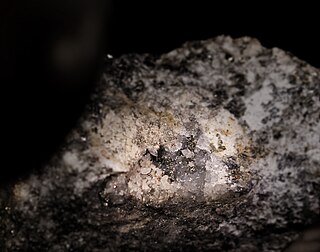
The mineral petzite, Ag3AuTe2, is a soft, steel-gray telluride mineral generally deposited by hydrothermal activity. It forms isometric crystals, and is usually associated with rare tellurium and gold minerals, often with silver, mercury, and copper.

Calaverite, or gold telluride, is an uncommon telluride of gold, a metallic mineral with the chemical formula AuTe2, with approximately 3% of the gold replaced by silver. It was first discovered in Calaveras County, California in 1861, and was named for the county in 1868.

Sylvanite or silver gold telluride, chemical formula (Ag,Au)Te2, is the most common telluride of gold.

Altaite, or lead telluride, is a yellowish white mineral with an isometric crystal structure. Altaite is in the galena group of minerals as it shares many of properties of galena. Altaite has an unusually high density for a light-colored mineral. Altaite and other rare tellurides are classified in the sulfide mineral class.
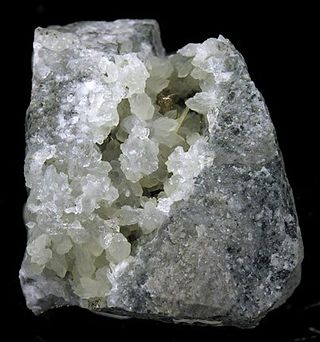
Krennerite is an orthorhombic gold telluride mineral which can contain variable amounts of silver in the structure. The formula is AuTe2, but specimen with gold substituted by up to 24% with silver have been found ([Au0.77Ag0.24]Te2). Both of the chemically similar gold-silver tellurides, calaverite and sylvanite, are in the monoclinic crystal system, whereas krennerite is orthorhombic.

Rickardite is a telluride mineral, a copper telluride (Cu7Te5) or Cu3-x (x = 0 to 0.36)Te2. It was first described for an occurrence in the Good Hope Mine, Vulcan district, Gunnison County, Colorado, US, and named for mining engineer Thomas Arthur Rickard (1864–1953). It is a low temperature hydrothermal mineral that occurs associated with vulcanite, native tellurium, cameronite, petzite, sylvanite, berthierite, pyrite, arsenopyrite and bornite.
Weissite is a telluride mineral, a copper telluride. Its chemical formula is Cu
2−xTe. Weissite has hexagonal crystal structure. Its specific gravity is 6 and its Mohs hardness is 3. Occurrence is in Gunnison County, Colorado, Arizona and New Mexico in the United States. It is also reported from Kalgoorlie, Western Australia and Dalarna and Värmland, Sweden.
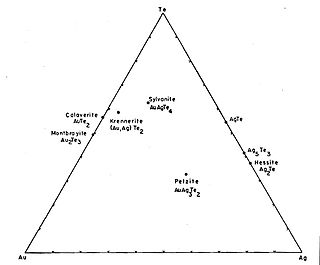
A telluride mineral is a mineral that has the telluride anion as a main component.
Saliotite is a rare colorless to pearl white phyllosilicate mineral in the smectite group with formula (Li,Na)Al3(AlSi3O10)(OH)5. It is an ordered 1:1 interstratification of cookeite and paragonite. It has perfect cleavage, a pearly luster and leaves a white streak. Its crystal structure is monoclinic, and it is a soft mineral with a hardness rated 2-3 on the Mohs scale.

Tellurobismuthite, or tellurbismuth, is a telluride mineral: bismuth telluride (Bi2Te3). It crystallizes in the trigonal system. There are natural cleavage planes in the (0001) direction as the crystal is effectively lamellar (layered) in that plane. The Mohs hardness is 1.5 - 2 and the specific gravity is 7.815. It is a dull grey color, which exhibits a splendent luster on fresh cleavage planes.

Hessite is a mineral form of disilver telluride (Ag2Te). It is a soft, dark grey telluride mineral which forms monoclinic crystals.

Empressite is a mineral form of silver telluride, AgTe. It is a rare, grey, orthorhombic mineral with which can form compact masses, rarely as bipyramidal crystals.
Temagamite is a bright white palladium mercury telluride mineral with a hardness of 2+1⁄2 on the Mohs scale. Its chemical formula is Pd3HgTe3. It was discovered at the Temagami Mine on Temagami Island, Lake Temagami in 1973, and it represents a rare mineral in the Temagami Greenstone Belt.
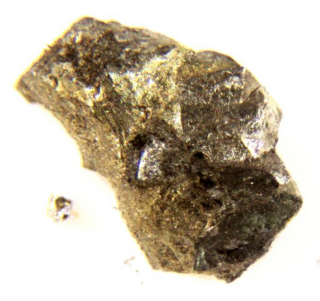
Vulcanite is a rare copper telluride mineral. The mineral has a metallic luster, and has a green or bronze-yellow tint. It has a hardness between 1 and 2 on the Mohs scale. Its crystal structure is orthorhombic.

Coloradoite, also known as mercury telluride (HgTe), is a rare telluride ore associated with metallic deposit. Gold usually occurs within tellurides, such as coloradoite, as a high-finess native metal.

Stützite or stuetzite is a silver telluride mineral with formula: Ag5−xTe3 (with x = 0.24 to 0.36) or Ag7Te4.
Merenskyite is a rare telluride / bismuthinide mineral with the chemical formula (Pd,Pt)(Te,Bi)2. It is an opaque white to light gray metallic mineral that occurs as inclusions within other minerals such as chalcopyrite. It crystallizes in the trigonal crystal system.
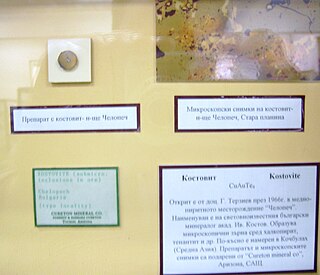
Kostovite is a rare orthorhombic-pyramidal gray white telluride mineral containing copper and gold with chemical formula AuCuTe4.
Honeaite is a rare gold thallium telluride mineral with the formula Au3TlTe2. It was discovered in the Karonie mine, Cowarna Downs Station, Western Australia, although this is not the only locality for the mineral.

















